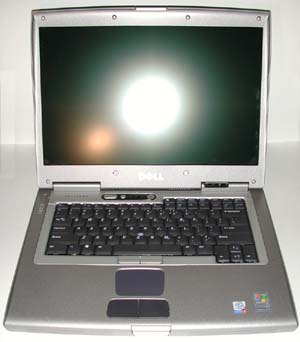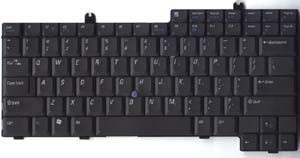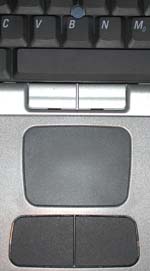Intel Centrino/Pentium-M Notebook Roundup: Dell, FIC and IBM Examined
by Matthew Witheiler on March 12, 2003 11:22 AM EST- Posted in
- Laptops
Dell Latitude D800 - Build, Appearance, Size
The first manufacturer we will look at with a Pentium M solution is Dell. Dell took advantage of the Pentium M launch to not only produce a notebook based on the processor but to also restyle their existing solutions. With the Pentium M, the Dell Latitude series notebook gets its first major facelift in years. The final product is the Dell Latitude D800, a full featured notebook that looks nothing like the Latitude C840 it replaces (this is a good thing). Sleek, silver and stylish are all words that come to mind. The system is a full Centrino solution, as it uses the Intel Pentium M processor, 855PM chipset, and Intel wireless card to produce one powerful notebook solution.
The first thing that will likely strike you about the Latitude D800 is its
display. Unlike your standard PC notebook display or LCD panel and more like
an Apple flat panel, the Dell Latitude D800 is outfitted with a 15.4" wide
screen display (16:10). The display, which runs at 1920x1200 (WUXGA) in the
highest end D800 and 1280x800 (WXGA) in the two lower end models, is truly breath
taking. At 1920x1200 the panel, which utilizes
Not only does the WUXGA display look nice, it also provides for an increase
in functionality over standard aspect ratio LCD panels. The 15.4" WUXGA
display provides 20% more desktop surface than a standard 15" UXGA screen.
This means that it is now possible to easily view two Microsoft Word pages at
once or a full Word page on one side and a full Internet Explorer window in
the other. No more
We suspect that Dell is onto something here with the wide screen display on the Latitude D800. Do not be surprised if you see more and more laptops come with a wide aspect LCD and more and more desktop LCD panels be offered in wide aspect ratios as well. We would love to configure our desktop with a display like the WUXGA screen on the Latitude D800.
To accommodate the 15.4" wide screen display the Latitude D800 is wider than any other notebook we have gotten our hands on. The majority of notebooks we have seen are square or nearly square in design. Thanks to its wide screen panel, the Latitude D800's footprint is a rectangle, with the width being 3.3 inches greater than the length. This accounts for the space around the Latitude D800's full sized keyboard.
The keyboard on the Latitude D800 includes all the keys we have come to expect from notebook keyboards including dedicated arrow keys in the lower right corner. The control key on the keyboard is in the standard location (far left) and is separated from the Windows key by the function key. The keyboard felt pretty standard, with a good amount of travel for a notebook keyboard and good tactile response.
Mouse input is provided by the "DualPoint" integrated pointing device. Like the Latitude C840 that it replaces, the DualPoint input system consists of both a touch pad and a track stick. Each input device has its own set of buttons and both sets have been revamped on the Latitude D800 to make them more responsive. We especially liked the new buttons tied to the track stick, although we did find them to be somewhat picky with where we pressed down to enable a click.
One thing that the D800 is missing is a scroll button of some sorts. This feature is also missing from the Latitude C840 that the system replaces.
Four status LEDs are found below the monitor on the monitor hinge. This allows the LEDs to be seen both with the screen open and with the screen closed. Here one can see power state, hard drive activity, battery state, and Bluetooth status.
![]()
The additional status LEDs are found above the keyboard. These lights indicate key states (number lock, caps lock, and scroll lock). To the right of these LEDs is the system's power button and to the left is a mute button followed by a volume up and a volume down button; welcome additions to the Latitude line. The microphone lies right above here, out of the way of our hands but also somewhat far away from the source of noise (our head).

Also visible with the screen open are two cooling vents. The first of these is located on the back left side of the system's top in the area to the left of the keyboard. This vent supplies cool air to the CPU fan which lies below here. The second vent is barely visible and located below the monitor along the gap between the monitor and the top of the system. This vent is an exhaust vent for a second cooling fan that the D800 employs (for what, we will have to wait and see).













3 Comments
View All Comments
builda - Thursday, February 2, 2006 - link
There appears to be a wide spread fault with the Gigabyte NB-1401 model notebook, where it reports having system disk errors or cannot find the hard disk. We have 7 of this model notebook and now 6 of them have reported the same problem. After running chkdsk to temporarily repair the errors that had been caused on the harddisk I found the problem returned the escalated to the point the harddisk could not be found. I further checked using Hitachi drive fitness testing tool which reported a cable error on each machine. Originally I returned 3 of these for repair as they were just outside the warranty period and the supplier checked with Gigabyte with the fix being to rub the cable all over with an eraser!! This worked for a short period but the problem has returned a couple of months later and has spread (like a virus) it now affects 6 out of the 7 notebooks. The supplier has just gone into administration and my next step is to approach Gigabyte who's support service has been found to be extremely unresponsive in the recent past.dbiberdorf - Tuesday, July 27, 2004 - link
I beg to differ with the reviewer. The keyboard on this unit is mediocre, and the track stick buttons are an abomination. They sit too low in the case and have too much travel. It makes my thumbs hurt after a while, and I often have to press them with a finger to get them to activate fully.The most powerful notebook in the world loses big points in my book if they built-in keyboard and pointing devices are weak. Certainly it's the case here. Dell, please figure out how to buy good keyboards for your machines!
Finally, the power adapter, while featuring convienent wrap-around cabling, is phenomenally large. My cordless phone at home is smaller. With the large profile of the machine, the adapter has to go in a side pocket of the carrying case, adding a little more bulge to your day.
visibilityunlimited - Thursday, October 30, 2003 - link
Screen resolution beyond SXGA+ would be unreadable using Windows for example while being more readable using Linux.Both the Linux text console and graphics mode X-windows-system screen drivers can be fully customized to display text at any resolution. The text characters could easily be displayed with current software at 1200dpi or more (if only the graphics processors and monitors could operate at that speed) and still retain the current character size. Text can currently be generated from vector based Type I and TrueType fonts for rasterizing at any resolution. Image scaling is a different and very easy problem.
The Windows OS is the real culprit holding back general usage of higher resolutions and typeset quality displays because of the OS being handicapped by the inertia of antique display modes. Darn. I want 3200x2400 or more!